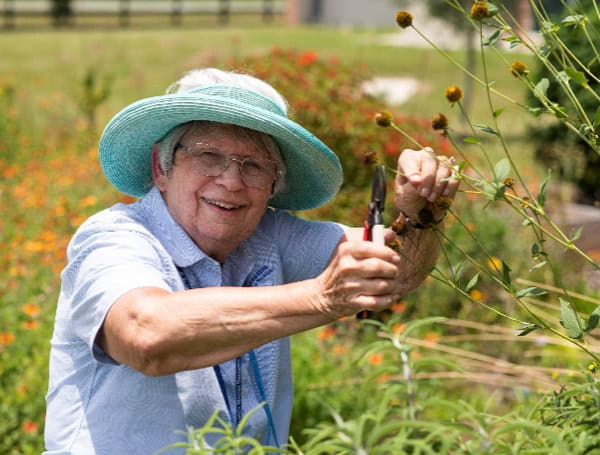Master Gardener Volunteer Lois McNamara cuts the seed heads off of wildflowers in the IFAS Extension Alachua County garden. (Photo by Cat Wofford, UF

Lois McNamara has been growing wildflowers for more than two decades, but she still remembers the species that endeared her to the hobby: blue larkspur.
“My daughter brought me seeds one year and threw them in a flowerbed, and the result was so beautiful that I wanted to do that, too,” said McNamara, a Master Gardener Volunteer with UF/IFAS Extension Alachua County.
Summer is an ideal time for Florida green thumbs undeterred by heat and rain to collect wildflower seeds for showy displays next year. Below, McNamara answers common questions about the practice.
Read: Agricultural Safety Center, UF/IFAS Release Heat-Related Illness Toolkit
Q. What wildflower species should seed collectors target during the summer?
A. While many of the wildflower species known for blooming along Florida roadsides in the spring have already gone to seed, summer bloomers like cutleaf coneflower, blanket flower and beach sunflower are all still growing and available.
Q. When and how are wildflower seeds typically harvested?
A. You can tell a wildflower is ready for harvesting when the seed head, the top part of the flower that has bloomed, turns brown. You can cut off the head, but often it’s possible to simply pull it off with your hands.
Q. How do you recommend separating the seeds?
A. If you shake the seed head of some wildflowers, the head will fall apart and reveal the seeds. With other wildflowers, you have to really work at the head with your fingers. If somebody’s going to get into seed saving for the long term, it’s worth having some sort of sieve. When I started, I ordered sieves from a mining company, and those fit perfectly along the rim of a 5-gallon bucket. You can also use colanders. One of my friends uses a sand-sifting toy for children.
Read: Agritourism In Florida: Exploring The Ultimate Farm Experience And Sunshine State Agriculture
Q. What is the best way to preserve seeds?
A. Before storing seeds, you need to ensure they are dry, so they don’t mold. If you keep them on paper in a house with air conditioning for about a month, that should do it. Afterward, if you’re going to use them next year, you can store them in a clear glass jar or in envelopes. For long-term storage, dark glass is recommended and preferable to plastic.
Q. When is the best time to plant the seeds collected now?
A. Cutleaf coneflower, blanket flower and beach sunflower are best sown in the fall between late October and mid-December. But optimal planting times depend on the species. In general, wildflower seeds can be sown in North Florida between mid-September and mid-October and in Central Florida from mid-October until the end of December.
Q. Can you describe the recommended planting method?
A. Work the soil very lightly; You don’t have to have all the vegetation up. If you have bahia grass in your yard, for example, you can mow it very closely, rake off the vegetation and then scatter the seeds and step on them. The seeds need exposure to the sun, they need good contact with the soil, and they need some water, and hopefully nature provides that. If not, you can provide it once a week.
Help support the Tampa Free Press by making any small donation by clicking here.
Android Users, Click To Download The Tampa Free Press App And Never Miss A Story. Follow Us On Facebook and Twitter. Sign up for our free newsletter.
